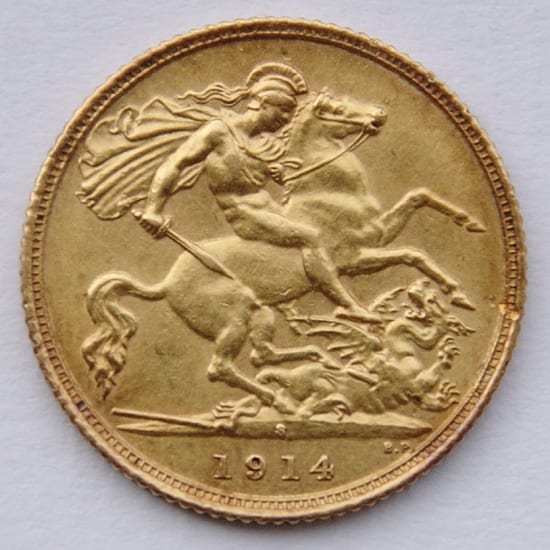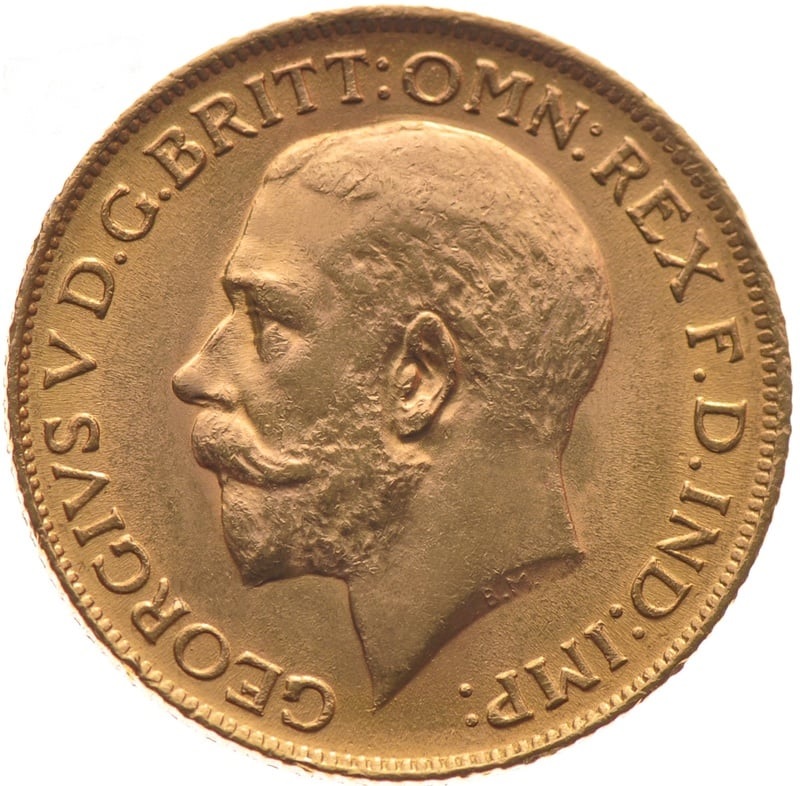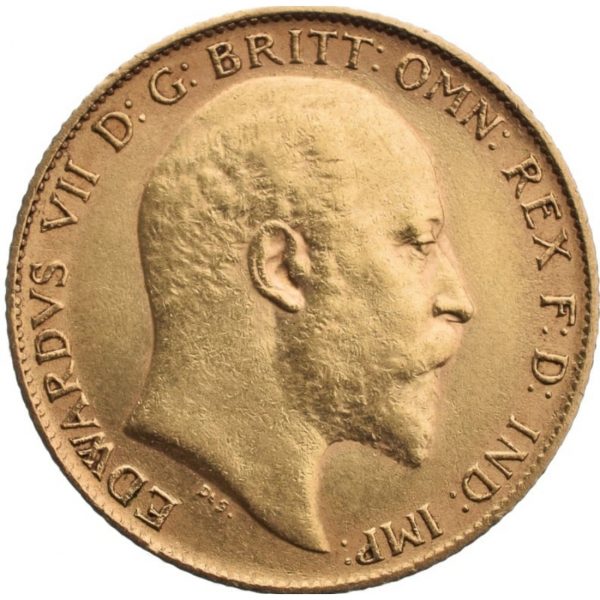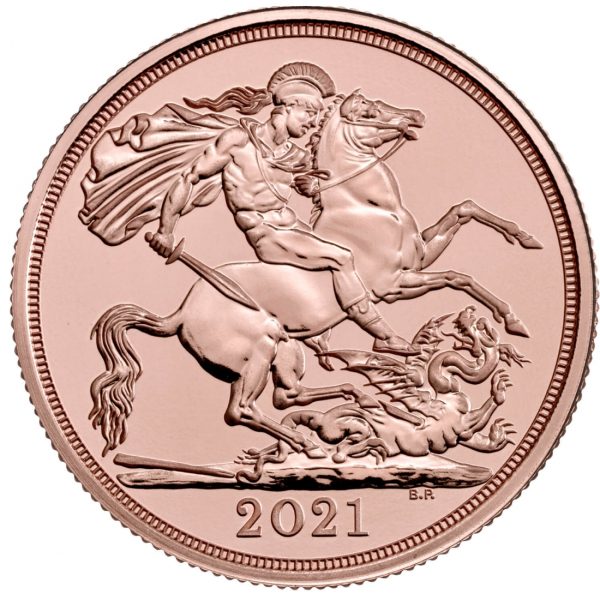King George V Sovereign – A Complete Guide
26/06/2023Daniel Fisher
Free & fully insured UK Delivery. Learn more
Secure & flexible payments. Learn more

Buyback Guarantee Learn more
King George V sovereigns are highly valued amongst numismatics due to being the last gold sovereign in actual circulation before the end of the Gold Standard in Britain.
Over the years, gold sovereigns have become a standout investment for collectors as they represent a significant part of British History and are considered legal tender in the UK. This means they areCapital Gains Tax exempt.

King George V reigned over the United Kingdom from 1910 to 1936, a period marked by significant events, including World War I and the beginning of the Great Depression. The sovereigns minted during his reign are a tangible link to this pivotal era in history.
The first King George V Sovereigns were struck in 1911, following the tradition of portraying the ruling monarch on the coin’s obverse. The coins feature the iconic design by Edgar Bertram Mackennal, an Australian sculptor, depicting the king in his coronation robes.
The sovereigns were minted in several branches of the Royal Mint across the British Empire, including London, Melbourne, Sydney, Perth, Ottawa, Bombay, and Pretoria. This global mintage adds an extra layer of intrigue and variety to these coins, making them highly sought after by collectors.
The production of King George V Sovereigns was a global operation, reflecting the vast reach of the British Empire during the early 20th century.
The Royal Mint had branches in several countries, each producing sovereigns with distinctive mint marks. These marks, usually a single letter, can be found on the ground above the date and indicate the mint of origin. For example, coins minted in London carry no mint mark, while those from Melbourne, Sydney, Perth, Ottawa, Bombay, and Pretoria carry the marks ‘M’, ‘S’, ‘P’, ‘C’, ‘I’, and ‘SA’, respectively.
The mintage numbers of King George V Sovereigns varied greatly from year to year and from mint to mint. Some years saw production in the millions, while others had much lower figures.
This variation, along with the different mint marks, contributes to the collectability of these coins. Collectors often seek to acquire sovereigns from each mint and from different years to complete their collections.
During the reign of King George V, the mintage of sovereigns was influenced by significant historical events, including the First World War and the expansion of the Royal Mint to new locations.
For instance, the Royal Mint briefly expanded to Bombay (now Mumbai) in India to increase output during the ongoing ‘Great War’. The Indian refinery began production in August 1918 and ran until early 1919.
A year after India stopped producing Sovereigns, the Ottawa refinery in Canada also ceased operation. The mint stayed active, however, and simply passed over to the Canadian authorities for domestic production.
In 1923, the Royal Mint expanded to one last new location. This site was to be in South Africa, with a new refinery established in Pretoria.
The mint would operate until 1932 when it was turned over to local authorities. It is now better known as the Rand Refinery and produces Krugerrand coins for the South African government.
George V gold sovereigns were produced to the same purity as other modern-era Sovereigns, in 91.67% fine gold (22 carats). The coin’s design was changed in 1929 to incorporate an inner circle and beading around the outside edge.
This extra level of security made it much harder for forgers of the time to replicate the coin, which is why the sovereign is still held in such high regard by collectors and investors.
The obverse of the George V Sovereign features his portrait by Australian-born engraver Edgar Bertram Mackennal. The task of creating the king’s depiction for the new coin’s was mandated after Mackennal impressed with his 1908 London Olympic medal designs. The engraver’s initials “BM” appear in the truncated neck of the effigy.
The king’s portrait faces left, continuing the tradition of each succeeding monarch’s head facing the opposite direction to the previous one, which started in the 17th century during the reign of Charles II. The exception to this rule came immediately after Charles V, with the brief reign of his eldest son Edward VIII before he abdicated. Although coins were never circulated due to the brief nature of his reign, Edward VIII insisted on his portrait also facing left, like his father’s, as he preferred that side of his face. This wish was granted in the designs. Coins featuring his sibling successor George VI also faced left, as if Edward’s portrait had faced right.
While it seems that this single portrait was used for the entire period of King George V’s coinage, there were actually two versions used.The original design was used on coins minted between 1911 and 1928. However, after production issues at The Royal Mint, a revised identical, but smaller version, appeared between 1929 and 1932.
Surrounding King Charles V’s image is the wording: GEORGIVS V D.G.BRITT:OMN:REX F.D.IND:IMP and the edging is milled to minimise thieves trying to shave off tiny fragments of gold.
The coin’s reverse displays the familiar fable of St. George slaying a dragon by Italian engraver Benedetto Pistrucci. His famous interpretation depicts the saint clutching a sword, sat astride his horse, which is trampling the wounded dragon. This design replaced the original version featured between 1817 and 1819 in which St.George was instead holding a broken spear, with other fragments in the dragon and on the ground beside it. The sword version has been used on the rear of the Gold Sovereign since.
Unlike some other Sovereign periods, those featuring George V never exhibited an alternative ‘shield-back’ reverse design. Most recently, the alternative shield of arms reverse is selected for Sovereigns minted during commemorative years such as jubilees. Notable examples during Elizabeth II’s reign are featured on the 2002, 2012 and 2022 Gold Sovereigns.
Get free insider tips to ensure you achieve the best investment returns
The 1917 George V gold sovereign is considered incredibly rare and is highly sought after by many coin collectors. This is because many of them were melted down after World War I to help pay off Britain’s war debts to America. Remember, the value of a coin is not just in its metal content or face value, but also in its historical significance, rarity, and condition. The 1917 George V sovereign is a prime example of a coin whose value far exceeds its weight in gold.
The 1917 George V sovereign features the classic design of St. George slaying the dragon on the reverse, created by Italian engraver Benedetto Pistrucci. The obverse features the portrait of King George V. It’s important to note that genuine 1917 sovereigns do not carry a mintmark, as they were minted in London. Any 1917 sovereign with a mintmark is not a genuine London issue.
The King George V Sovereigns are more than just gold coins; they are a piece of history. Minted during significant global events, including World War I and the onset of the Great Depression, these coins offer a glimpse into the past.
The sovereigns bear the portrait of King George V, who reigned during these challenging times, making them a tangible connection to this pivotal era in history.
Moreover, the sovereigns are a testament to the global reach of the British Empire in the early 20th century. They were minted in various branches of the Royal Mint across the globe, from London to Bombay to Pretoria.
This global mintage adds an extra layer of intrigue and variety to these coins, making them a fascinating subject of study for historians and numismatists alike.
Our portfolio Creator shows you the best precious metal investment for your budget.
For coin collectors, King George V Sovereigns hold a special appeal. The variation in mintage numbers and mint marks make these coins highly collectable. Collectors often seek to acquire sovereigns from each mint and from different years to complete their collections.
The challenge of finding specific coins, especially those with lower mintage numbers or from less common mints, adds to the thrill of collecting.
Furthermore, these coins’ historical significance and beautiful design make them a prized addition to any collection.
The portrait of King George V in his coronation robes, the iconic image of St. George slaying the dragon, and the various mint marks all contribute to the aesthetic appeal of these coins.
Whether you’re a seasoned numismatist or a beginner in coin collecting, King George V Sovereigns offer a rewarding and engaging collecting experience.

Remember, the key to successful coin collecting is patience, education, and building relationships with trusted dealers.
Gold sovereigns are considered semi numismatics. This means collectors buy them for both their bullion content as well as their numismatic (rarity/historical value).
Due to the coin’s everlasting popularity with collectors from all over the globe, gold sovereigns are relatively liquid which means they are easily exchangeable for cash.
We have a huge amount of experience in the buying and selling of gold sovereign coins, with many trusted 5-star reviews to back it up. A member of our team is always available to offer guidance on purchasing or selling Gold Sovereigns if you need. Our wide stock of pre-owned Sovereigns have all been checked for quality and condition by our numismatic team to ensure we only offer the best products for investment and collectors.


Live Gold Spot Price in Sterling. Gold is one of the densest of all metals. It is a good conductor of heat and electricity. It is also soft and the most malleable and ductile of the elements; an ounce (31.1 grams; gold is weighed in troy ounces) can be beaten out to 187 square feet (about 17 square metres) in extremely thin sheets called gold leaf.
Live Silver Spot Price in Sterling. Silver (Ag), chemical element, a white lustrous metal valued for its decorative beauty and electrical conductivity. Silver is located in Group 11 (Ib) and Period 5 of the periodic table, between copper (Period 4) and gold (Period 6), and its physical and chemical properties are intermediate between those two metals.